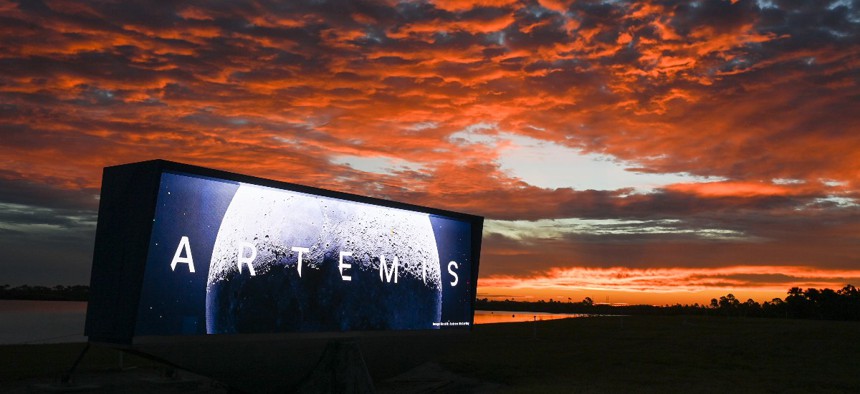NASA Needs Better International Cooperation Framework for Artemis Missions, IG Says

Jonathan Newton/The Washington Post via Getty Images
The watchdog made 10 recommendations to the agency to improve international collaboration and help reduce costs.
Despite international interest in the Artemis missions that are planned to take astronauts to the moon and Mars, NASA still needs to develop an overall strategy for international space cooperation and collaboration, the agency’s Office of the Inspector General found.
According to Tuesday’s OIG report, NASA has 54 Artemis-related international instruments, in addition to important commitments from the Canadian Space Agency, European Space Agency and Japan Aerospace Exploration Agency, and 23 nations signed the Artemis Accords—the guiding principles for peaceful international cooperation for outer space exploration for the Artemis missions. But NASA “lacks an overarching strategy to coordinate Artemis contributions from international space agencies and entities,” the watchdog found.
With the exception of a planned orbiting lunar outpost known as the Gateway Program, the Artemis program “does not have comprehensive forums—boards, panels and working groups—for its international partners to routinely discuss topics such as flight and mission planning, safety and research integration.” According to the report, this lack of planned cooperation is in stark contrast with the International Space Station, which is a model for long-term international space cooperation. The ISS utilizes the aforementioned forums and on-site presence from partner agencies.
The watchdog noted that NASA has a clear plan for the first three Artemis missions, but beyond Artemis IV the agency does not have well-defined plans for lunar exploration that cover important details like costs and responsibilities for its international partners. OIG added that while NASA worked to develop a plan in May 2022 “for sustained human presence throughout the solar system,” it is “too early to tell if these efforts will clarify the potential funding, roles and responsibilities required of international partners for participation in the Artemis campaign.” Moreover, OIG stated that there is no existing cooperative framework for Artemis-related agreements to address legal structure, program development or respective roles and responsibilities.
OIG stated that the International Traffic in Arms Regulations and Export Administration Regulations—which cover export controls of defense and commercial items in order to safeguard U.S. interests and intellectual property—can be “complex and restrictive,” which could limit NASA’s capability for international collaboration on Artemis. For example, NASA cannot use astronauts from a partnering country or share information with them before and after a mission. The watchdog noted that Artemis should look to the ISS for guidance. For example, OIG suggested that Artemis have a unique Export Administration Regulation classification for specific space-flight items, or consistent jurisdiction and classification of Artemis items, to make it easier to quickly share information with partners.
OIG added that NASA is trying to share costs with its international partners via partner-provided capabilities like spaceflight hardware or robotics, with the cost determined at the beginning of the agreement. OIG stated that NASA’s uncrewed and robotic spaceflight projects typically “experienced less cost growth despite higher levels of complexity,” which could be a result of the agency’s international partners using trade studies and firm-fixed contracts. The watchdog stated that with NASA’s current budget, it will not be able to achieve its long-term Artemis goals without utilizing “international partner cost management strategies.”
OIG made 10 recommendations to the agency to improve NASA’s cooperation with international partners. Specifically, the watchdog recommended that NASA leadership:
- Create a strategy to coordinate with international partners, which includes recurring forums for Artemis Accords signatories that want to participate in the Artemis missions.
- Develop NASA-led Artemis program boards and working groups for partners with agreed commitments and opportunities for intermediary representation from international partners.
- Provide a detailed strategy and plan for missions beyond Artemis IV that details international partner roles and responsibilities.
- Work on a detailed gap analysis and cost estimate for the missions after Artemis IV to help create a cost-sharing strategy with partners.
- Form a full-time export control team to solely support Artemis space flight developments.
- Form another full-time export control team dedicated to Artemis space flight operations.
- Examine export control requirements and think about additional roles for partner astronauts to use for NASA space flight operations.
- Work with other federal agencies to create a unique EAR classification for the Gateway program.
- Carry out Artemis agreements with international space agency partners to make sure they clearly understand their roles and responsibilities.
- Establish an automated routing method to process international agreements within NASA to improve timeliness.
According to OIG, NASA agreed with nine out of the 10 recommendations and the agency outlined actions to address them. NASA did not agree with the fourth recommendation relating to a gap analysis and cost estimate for Artemis.






